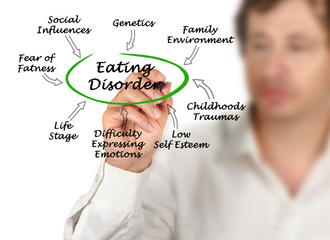Written by: Irina Gelman, PsyD, Site Director at The Renfrew Center of West Palm Beach

These barriers often sound like automatic thoughts such as, “I should be able to do this by myself,” “If it was really that bad, I would know it” or “My parents will be so disappointed if I have to withdraw from classes.” It may also sound like, “I don’t care about the consequences,” “Treatment won’t help me” or “I don’t see what the big deal is anyway.”
Tip #1: Determine If A Higher Level Care Is Needed
So, what can we, as clinicians, do when our clients are telling us that they are not “sick enough for treatment?”
First, you will need to determine if your client’s assessment could be missing vital information. Here are a few questions to keep in mind:
- What is your client’s level of motivation for treatment or recovery?
- Are you trying to understand their concerns about a step up to a higher level of care or exploring their previous experiences with providers?
- Who does the support system consist of, and what are those individuals’ attitudes towards treatment? How will your client’s caregivers feel about their child going on medical leave and withdrawing from classes? Has their significant other reported “seeing the signs” but didn’t know how to provide support? Are the individuals in their support system on the same page?
- Have you identified who the treatment team consists of and created a collaborative relationship with the other members?
Tip #2: Build Consensus With Other Providers
When we are considering a higher level of care for our clients, especially if we are being met with resistance, it’s helpful when all our client’s providers agree about the recommendations. The client may have great rapport with their therapist or dietitian; however, in other cases the best relationship may be with their pediatrician/doctor who they’ve been working with for years, an endocrinologist who has been helping them manage their diabetes or a gastroenterologist who helped them rule out the causes of their stomach aches.
Tip #3: Assess the Client’s Relationship to Food & Exercise
Disordered behaviors will be present in all levels of care, but the deciding factor will rely on the severity, intensity and frequency of the behaviors. Think about your client’s relationship with food and exercise – how much of an impairment has it become? Are they skipping classes to exercise? Are they so tired that they’ve been missing activities they used to enjoy?
Tip #4: Factor in Any Medical Complications
Medical complications commonly arise due to the behaviors they are engaging in. It could be co-occurring illnesses that may be exacerbated by the eating disorder, or it could be ways in which the medical illness is even used in service of the eating disorder. Important medical questions to consider include:
- Is their lab work within normal limits?
- Have they reported feeling dizzy, fainting or falling recently?
- Is their EKG normal?
- When was their last missed period?
- Has there been significant weight fluctuations in the last six months?
- Are they refusing to take a certain type of medication because they are worried that one of the side effects is possible weight gain?
Tip #5: Evaluate the Impact from Mood & Anxiety
When you are considering a higher level of care, examine the impact your client’s mood and anxiety may be having on their relationships. Are they normally very close with their family, but are now skipping family dinners, not going home for the holidays, missing weddings or big celebrations based on their anxiety about eating in front of others or the meal that’s going to be served?
Tip #6: Ensure Whether the Client is a Danger to Themselves
As a clinician, you will want to identify if your client is engaging in self-harm, using substances or reporting suicidality. Assess the progress that has been made with their outpatient treatment team and consider whether you are operating within the scope of your expertise given the client’s presenting concerns.
Tip #7: Help Them Feel Motivated About Clinical Care
A client’s level of motivation can be the deciding factor in stepping up to a higher level of care. To enhance motivation, seek to express empathy, develop discrepancy, roll with resistance, and bolster self-efficacy.
Start with empathy because behavioral change is only possible when your client feels personally accepted and valued. Make sure that you are developing discrepancy between the client’s current behavior and how they would like their life to be—this is done so that the desire to change comes from within.
Your client should become aware of the inconsistencies between what they are doing and their core values. What are the ways in which engaging in their eating disorder is not in line with the things that are important to them in their lives? They need to believe that they have the resources and capabilities to overcome barriers and be successful.
Tip #8: How to Help a Client Who Thinks They Aren’t “Sick Enough”
If a client is resistant to your recommendations and believes that they are “not sick enough to go to treatment” – we can label that cognition as an appraisal. It’s an interpretation that our client is making about the situation in front of them. As you teach your client about automatic appraisals, stress that these interpretations are automatic—meaning that they immediately come up without our control, they are subjective, they are not necessarily true and that they are often judgmental.
While we can’t unthink an automatic thought, we can examine it, decide if we have fallen into a “thinking trap,” and identify any alternative ways to see the same situation (also known as a reappraisal). Reappraising can help increase your client’s flexibility and expand the possibilities beyond their initial, automatic thoughts.
Thinking traps are just some of the ways that we can label common automatic appraisals. These are merely interpretations that we make repeatedly, and they start starts to feel powerful, rigid, and seemingly true. Thinking traps interfere with seeing all the alternative ways of looking at a situation.
Conclusion
When considering a higher level of care, team members should be actively collaborating and assessing whether the client would benefit from additional support, structure, or supervision. Ongoing evaluation of various factors, such as the severity and frequency of disordered behaviors, the client’s safety, medical status, social functioning, and psychological concerns should inform the decision-making process.
When your client says, “I’m not sick enough to go to treatment,” you are not there to dispute the thought, stop them from having the thought or change the thought itself. Unless the client is in immediate danger, you are there to help them think more flexibly, to identify that this might be a thinking trap and invite them to explore alternative interpretations of their situation. You are there to help them feel seen and deeply understood, and hopefully enhance their motivation to prioritize their physical and mental wellbeing.


